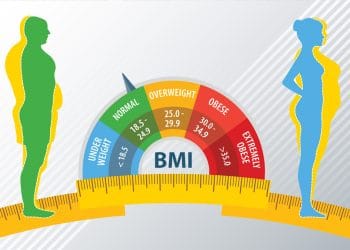The BSA or body surface area calculator is used to determine the total body surface area of an individual. It’s a method typically used in a medical setting and is often preferred over using bodyweight, for a more accurate estimate of a body’s energy needs. This is based on an estimate of metabolic mass (mostly fat-free mass) as abnormal fat mass is not metabolically active.
Weight
Height
BSA Equation:
BSA is used to assess an individual’s heart function in relation to their physical size (cardiac output). It’s also used to help find optimal medication dosages as body size plays a role in determining an appropriate dose for effective treatment.
Chemotherapy treatment dosages are often administered using the BSA calculation as well as renal clearance and glucocorticoid dosing. Although, there has been opposing opinion about using this method for chemotherapy especially because certain drugs used for treatment have a narrow therapeutic index. This would cause serious adverse effects. But these methods are used in a clinical and lab setting.
Although, we can also use BSA for fitness/health calculations.
Most Accurate Method For Calculating BSA
Finding the exact BSA of an individual is not always accurate or simple. The first formula was developed by Du Bois in 1916 but since then, there have been many formulas developed that are used to help determine an approximation of BSA.
Although, we do recommend using the Du Bois or Mosteller formula as these are the most widely used formulas. (1)
Level Up Your Fitness: Join our 💪 strong community in Fitness Volt Newsletter. Get daily inspiration, expert-backed workouts, nutrition tips, the latest in strength sports, and the support you need to reach your goals. Subscribe for free!
The Du Bois formula has shown to estimate body fat more accurately than BMI (body mass index) for obese and non-obese individuals, which is entirely noteworthy. On the other hand, it had shown some inconsistencies by a few percent as well. But the Mostellar formula, for example, is a simple and easy to remember formula that is recommended due to its simplicity.
You can, however, experiment with the different formulas to see how they affect your results.
BSA (body surface area) vs. BMI (body mass index)
This method of calculation is often compared to BMI (body mass index) to determine body mass values and markers of health.
However, there are some differences. For instance, BMI is a basic, commonly used tool for determining a healthy body weight range. It does a decent job at this and is used for this purpose in a healthcare setting as well. BMI is calculated based on height and weight. It’s also used to determine an individual’s potential for health risk.
But what BMI doesn’t do, is consider whether someone has a decent amount of muscles (sports athletes, bodybuilders, etc). Consequently, body fat may be overestimated. It also doesn’t consider age or muscle loss. So, one may be less or more healthy, in general, than what the calculator estimates.
The BMI formula takes the body weight in kg and divides it by height in meters squared. Then, it’s measured against predetermined values to determine the health range based on an individual’s body weight. In contrast, a formula such as the Mosteller takes the square root of the height (cm) multiplied by the weight (kg) divided by 3600.
This formula is preferred for easily measuring body composition or muscle-to-fat ratio based on someone’s height, weight, and age.
Now, the average adult BSA (body surface area) is 1.7 m^2 (1.9 m2 for adult males and 1.6 m2 for adult females). But age and gender also play a role in addition to height and weight.
Here are the average body surface area values…
- Adult Men 1.9 m2
- Adult Women 1.6 m2
- Child (12-13 years) 1.33 m2
- Child (10 years) 1.14 m2
- Child (9 years) 1.07 m2
- Child (2 years) 0.5 m2
- Neonate 0.25 m2
After you calculate and get your results, you can use the following information to compare your results to. If you get a calculation much higher or lower, this would indicate a percentage off of the average and therefore, you’d have to adjust calories and other factors accordingly to ensure you remain within an optimal range.
Table of BSA averages
| ft2 | m2 | |
| Newborn child: | 2.69 | 0.25 |
| Two-year-old child: | 5.38 | 0.5 |
| Ten-year-old child: | 12.27 | 1.14 |
| Adult female: | 17.22 | 1.6 |
| Adult male: | 20.45 | 1.9 |
Here’s an example of BSA results if you were a 5’9,” 155lb male.
This is a great tool for measuring your results in different units.
| Formula | Results in different units | ||
| Du Bois | 1.83 m2 | 19.65 ft2 | 2,830 in2 |
| Mosteller | 1.81 m2 | 19.47 ft2 | 2,803 in2 |
| Haycock | 1.80 m2 | 19.42 ft2 | 2,796 in2 |
| Gehan & George | 1.81 m2 | 19.52 ft2 | 2,811 in2 |
| Boyd | 1.80 m2 | 19.42 ft2 | 2,796 in2 |
| Fujimoto | 1.76 m2 | 18.97 ft2 | 2,732 in2 |
| Takahira | 1.84 m2 | 19.81 ft2 | 2,853 in2 |
| Schlich | 1.76 m2 | 18.92 ft2 | 2,724 in2 |
Formulas Used In The Calculator
There are several formulas that you can select when computing your BSA which is expressed in the following formulae by weight (W) in kg, and height (H) in cm. There generally isn’t a big difference between these formulas and it’d be impossible to be perfect with your calculations.
Du Bois formula:
BSA = 0.007184 × W0.425 × H0.725
Mosteller formula:
BSA = = 0.016667 × W0.5 × H0.5
Haycock formula:
BSA = 0.024265 × W0.5378 × H0.3964
Gehan and George formula:
BSA = 0.0235 × W0.51456 × H0.42246
Boyd formula:
BSA = 0.03330 × W(0.6157 – 0.0188 × log10(W) × H0.3
Fujimoto formula:
BSA = 0.008883 × W0.444 × H0.663
Takahira formula:
BSA = 0.007241 × W0.425 × H0.725
Schlich formula:
Women BSA = 0.000975482 × W0.46 × H1.08
Men BSA = 0.000579479 × W0.38 × H1.24
What Can I Use These Calculations For?
BSA can be used for health/fitness purposes such as determining energy expenditure in the form of BMR (basal metabolic rate), RMR (resting metabolic rate), TDEE (total daily energy expenditure), REE (resting energy expenditure), and RDEE (resting daily energy expenditure).
These are utilized to determine dietary needs based on the individual to be within a healthy range. And since we’re all different, so will our nutritional requirements be. And this too, is largely affected by gender and age in addition to height and weight.
BSA is also used to help estimate the muscle-to-fat ratio as mentioned before. If you’re outside of the ranges in the provided charts, then you’ll have to make adjustments if you want to fit within the average BSA.
BMR and Differences Between Individuals
As an example of how BMR or metabolism at rest relates to energy expenditure, energy needs will be different for a young athlete when compared to an elderly individual. This is just largely due to the differences in body composition (muscle-to-fat ratio). That’s because BMR is largely determined by fat-free mass.
But the body’s energy needs, hormones, activity levels, and environmental temperature also play a role. (2)
Activity levels contribute to the body’s ability to burn calories to a large degree though. But as you can see, there are severe factors that contribute to BMR. Although, there are more factors as well but are not as significant.
Also try other relegated calculators:
- Creatine Calculator
- LBM Calculator
- Macronutrient Calculator
- TDEE Calculator
- Carb Cycling Calculator
- Intermittent Fasting Calculator
- Water Fasting Weight Loss Calculator
- Body Fat Calculator
- Weight Loss Percentage
Wrapping Up
The BSA calculator is simply a measurement of total body surface area. And therefore, you can use it to determine different areas of health and fitness as explained. It’s a great tool for measuring energy expenditure based on fat-free, metabolic mass, and even giving you a body composition estimate based on the formula used.








